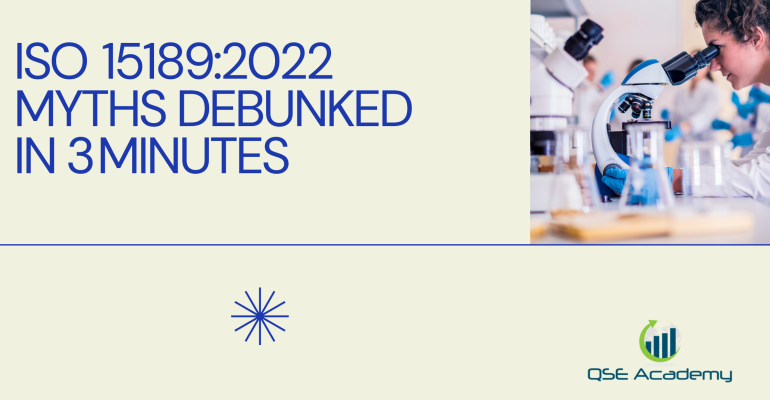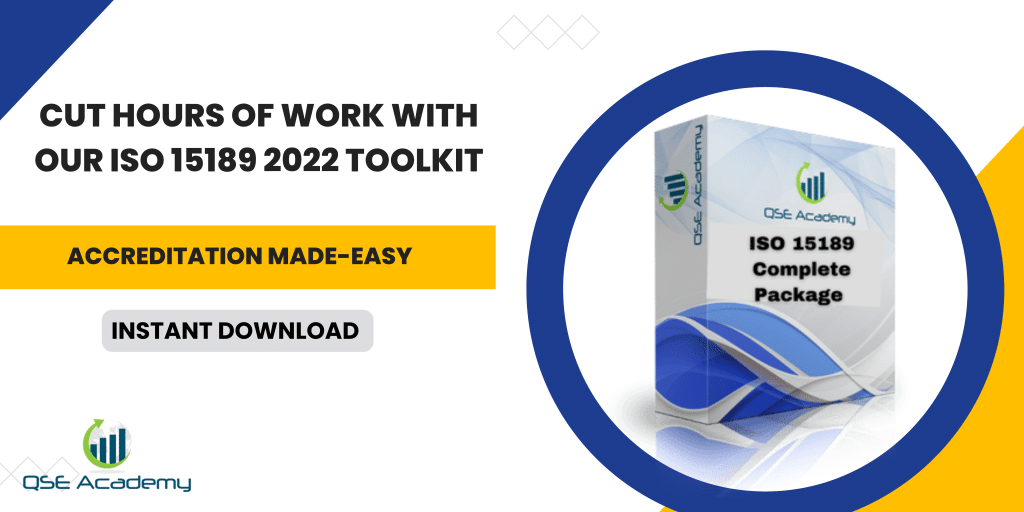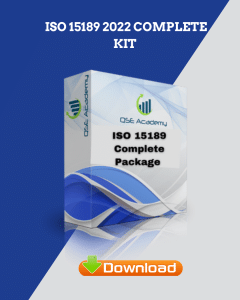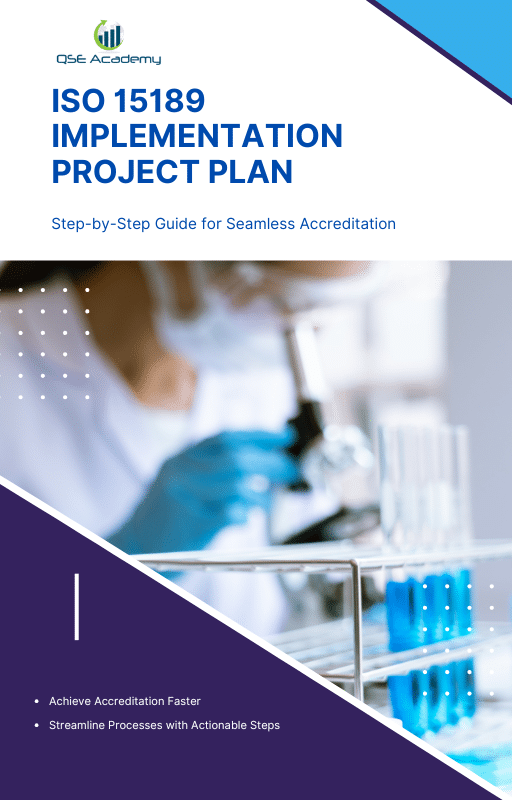ISO 15189:2022 Myths Debunked in 3 Minutes
Last Updated on October 22, 2025 by Hafsa J.
The Truth Behind ISO 15189 Accreditation
I’ve lost count of how many times I’ve heard a lab manager say, “ISO 15189? Oh, that’s too complicated for us.”
Usually, they’ve heard half-truths from colleagues or competitors—and those myths keep them from taking a step that could completely transform their lab.
Here’s the reality: ISO 15189:2022 isn’t as intimidating as it sounds. It’s not just for big hospitals. It’s not a paperwork marathon. And it’s definitely not a waste of money.
In fact, for clinical and diagnostic laboratories, it’s one of the smartest moves you can make to improve reliability, attract clients, and build international credibility.
In this quick read, we’ll debunk the most common myths about ISO 15189 accreditation—the ones that stop most labs before they even start.
Give me three minutes, and I’ll show you why every modern lab can (and should) pursue ISO 15189 with confidence.
Myth #1 – “ISO 15189 Is Only for Big Hospitals and National Labs”
This is the myth I hear most often—and it couldn’t be further from the truth.
ISO 15189 was designed to fit any laboratory that performs medical testing, regardless of size or location. It doesn’t matter if you’re a two-person clinic in a provincial town or a multi-department hospital lab in a capital city—the standard scales to you.
I’ve personally helped small community labs with just one analyzer earn ISO 15189 accreditation. Those same labs later won contracts from major hospitals because their accreditation proved something powerful: competence and consistency matter more than size.
Here’s the real secret:
ISO 15189 is flexible. It doesn’t tell you how big your lab should be—it tells you how good your lab should be.
If you can show that your processes are controlled, your people are competent, and your results are accurate, you’re already on the right path.
Pro Tip:
Start small. You can implement ISO 15189 in stages—department by department—without disrupting daily operations. The key is steady progress, not perfection from day one.
Now that we’ve cleared that up, let’s tackle the next big misconception: that ISO 15189 is too expensive and not worth the investment.
Myth #2 – “ISO 15189 Is Too Expensive and Not Worth It”
This one comes up in almost every initial consultation:
“ISO 15189 sounds great, but we just can’t afford it right now.”
I get it. On the surface, accreditation looks like a big investment — assessments, training, documentation, maybe even new equipment. But here’s what most labs don’t realize: ISO 15189 pays for itself faster than you think.
When you streamline your processes, you waste less time, fewer reagents, and catch errors early — long before they cost you clients or credibility.
I’ve seen labs recoup their costs within 6 to 12 months, simply by tightening up their quality controls, optimizing workflows, and reducing repeat testing.
One of my clients, a mid-sized diagnostic center, was losing thousands every quarter due to sample re-runs and reagent waste. After ISO 15189 implementation, they reduced errors by 40%, saved over $15,000 in a year, and — best of all — gained new hospital clients because of their accreditation status.
Pro Tip:
Don’t think of ISO 15189 as an expense — think of it as a return on discipline. The more you standardize and monitor, the more efficient your lab becomes. The savings and new opportunities will follow naturally.
Next, let’s debunk the myth that makes most lab teams roll their eyes — the idea that ISO 15189 is nothing but paperwork and red tape.
Myth #3 – “ISO 15189 Is Just Paperwork and Bureaucracy”
Let’s be honest—when people hear “ISO,” they picture binders full of documents, endless checklists, and a quality manager buried under forms.
But that’s not what ISO 15189 is really about.
Yes, documentation is part of the process—but it’s not paperwork for paperwork’s sake. It’s proof of consistency. It shows that your lab can repeat success, not repeat mistakes.
Here’s the truth:
The documentation ISO 15189 requires—like SOPs, validation records, and quality logs—already exists in most labs. The difference is that accreditation makes them organized, standardized, and usable.
Instead of chasing signatures and files, you’ll finally have a clear system that helps your team understand what to do, how to do it, and how to prove it.
One client put it perfectly: “Before ISO 15189, our procedures lived in people’s heads. Now they live in our system—and that makes all the difference.”
Pro Tip:
Think of documentation as your lab’s memory. It captures what works, prevents confusion, and ensures quality even when staff change or workload spikes.
Good documentation doesn’t slow you down—it protects your lab from chaos.
Now that we’ve cleared the paperwork myth, let’s move on to another common misunderstanding: the belief that once you’re accredited, you’re done for good.
Myth #4 – “Once You’re Accredited, You’re Done Forever”
A lot of labs breathe a sigh of relief after getting their accreditation certificate — and then assume the hard work is over.
But here’s the truth: ISO 15189 is not a one-time achievement. It’s a continuous commitment.
Accreditation doesn’t end when you pass the audit. It evolves with your lab. Every new piece of equipment, every updated test method, and every staff change brings new risks — and ISO 15189 helps you stay ahead of them.
Accredited labs go through regular surveillance visits (usually every year) to confirm that their systems are still working. But if you’ve truly integrated the standard into daily operations, those follow-up audits feel natural — not stressful.
I once worked with a clinical chemistry lab that treated ISO 15189 like an ongoing improvement tool. They used their internal audits to spot small issues, like recurring calibration delays, and fixed them long before the next assessment. When the accreditation body came back, they found zero nonconformities — because the lab never stopped improving.
Pro Tip:
Think of ISO 15189 as your lab’s health check. You don’t get fit once and stop exercising — you maintain it. The same principle applies here. The more consistently you nurture your system, the easier it becomes to sustain accreditation long-term.
Now let’s clear up another big misunderstanding — the belief that if you already have CLIA or national approval, you don’t need ISO 15189.
Myth #5 – “CLIA or National Licenses Make ISO 15189 Unnecessary”
This myth is especially common in the U.S. and countries with strong national regulations.
Many lab managers think, “We’re already CLIA certified — why bother with ISO 15189?”
Here’s the simple answer: CLIA is about compliance. ISO 15189 is about competence.
CLIA (or your country’s equivalent license) proves you meet the minimum legal requirements to operate. ISO 15189 proves your lab operates at an internationally recognized level of quality and reliability.
CLIA makes sure you’re doing things correctly. ISO 15189 ensures you’re doing the right things — consistently, ethically, and with traceable accuracy.
Think of it this way:
-
CLIA is your driver’s license. It lets you drive legally.
-
ISO 15189 is your international passport. It allows your results to travel — trusted and recognized anywhere in the world.
Example:
A molecular diagnostics lab in California already had CLIA certification, but they pursued ISO 15189 to join global COVID-19 testing studies. Their accreditation opened partnerships with hospitals in Europe and Asia — opportunities they couldn’t access before.
Pro Tip:
If your lab plans to work with international clients, clinical trials, or global research partners, ISO 15189 is your credibility multiplier. It complements your national license — it doesn’t replace it.
Now that we’ve cleared that up, let’s tackle one final myth that often discourages labs from even starting — the idea that ISO 15189 takes years to achieve.
Myth #6 – “It Takes Years to Get Accredited”
This one scares a lot of labs away before they even begin.
Someone always says, “It’ll take two or three years to get ISO 15189—we don’t have that kind of time.”
Here’s the truth: most laboratories can achieve accreditation in 6 to 12 months with proper planning and focus. The key is structure, not speed.
ISO 15189 isn’t designed to slow you down—it’s designed to fit into how your lab already works. When you break the process into clear stages, it becomes manageable and surprisingly efficient.
Here’s a simple timeline I share with clients:
-
Months 1–2: Conduct a gap analysis and train your team.
-
Months 3–6: Implement your Quality Management System (QMS) and run internal audits.
-
Months 7–9: Fix gaps, finalize documentation, and prepare for the assessment.
-
Months 10–12: Undergo accreditation audit and finalize improvements.
That’s it. Twelve months of consistent effort—and your lab can be fully accredited.
Example:
A medium-sized pathology lab I worked with started from scratch and earned ISO 15189 accreditation in nine months. They didn’t rush—they just followed a roadmap, delegated tasks, and stayed committed.
Pro Tip:
Start small, but start now. You don’t need to have every document ready to begin. Build your system while you work—it’s faster and far more effective than waiting for “the perfect time.”
Now that we’ve covered the timeline myth, let’s look at one final misconception: the belief that ISO 15189 is only for technical or scientific people.
Myth #7 – “ISO 15189 Is Only for Technical People”
This one always makes me smile because it’s half true — ISO 15189 does rely on technical competence, but it’s far from a one-person job.
Accreditation is a team sport. It needs everyone — from lab technologists to admin staff, from logistics to leadership.
Why? Because ISO 15189 touches every part of how your lab runs, not just the testing itself.
Here’s what I mean:
-
Admin staff manage records, contracts, and client communication — all vital for traceability.
-
Logistics and specimen handlers ensure samples are transported and stored under correct conditions.
-
Supervisors and quality managers guide training, corrective actions, and risk management.
-
Top management sets the tone for leadership commitment and continual improvement.
In one accredited lab I worked with, even the delivery drivers were trained under ISO 15189 protocols. They learned how temperature and timing affect sample integrity — and because of that, the lab’s rejection rate for transported specimens dropped by 60%.
Pro Tip:
ISO 15189 works best when everyone owns quality. Involve your team early, explain the “why” behind the system, and celebrate small wins along the way. That’s how a quality culture sticks.
Now that we’ve debunked the most common myths, let’s wrap this up with a quick summary — the real story behind ISO 15189, in under three minutes.
Quick Recap – The Real Story in 3 Minutes
Let’s boil it all down.
ISO 15189:2022 isn’t about red tape or big budgets—it’s about trust, structure, and continual improvement.
Here’s what you really need to remember:
-
Size doesn’t matter. Small or large, any lab can meet ISO 15189 requirements.
-
It’s affordable—and it pays off fast. The efficiency gains and client confidence far outweigh the initial costs.
-
It’s not about paperwork. It’s about process control, accountability, and consistent quality.
-
Accreditation never “ends.” You maintain it by improving a little every day.
-
It complements, not replaces, local licenses. CLIA proves compliance; ISO 15189 proves competence.
-
It doesn’t take forever. With the right plan, you can get accredited within a year.
-
It’s for everyone in your lab. From the front desk to the analyzer bench—quality is everyone’s job.
In short, ISO 15189 isn’t the monster people make it out to be. It’s a roadmap that helps you reduce errors, gain respect, and elevate your lab to world-class status.
Pro Tip:
Don’t wait for “the right time.” Start the conversation now. You’ll be amazed at how much smoother your daily operations become when everyone starts thinking the ISO way.
Now let’s close with one final thought — how moving past these myths can turn ISO 15189 from an obstacle into your lab’s greatest advantage.
From Myths to Momentum
Here’s the real takeaway: ISO 15189:2022 isn’t a burden—it’s a blueprint for excellence.
Most of the fear surrounding accreditation comes from misunderstanding. Once labs see how practical the system is, they realize it’s not about adding work—it’s about organizing what they already do and proving it works.
Labs that embrace ISO 15189 don’t just get certificates—they gain control, confidence, and credibility. Their teams know what to do, their clients trust their results, and their operations become easier to manage because quality isn’t an afterthought—it’s built in.
In my experience, the labs that move fastest are the ones that stop overthinking and start small. A gap analysis, a few documented procedures, and clear roles can set everything in motion. Before long, ISO 15189 stops feeling like a standard and starts feeling like common sense.
Pro Tip:
Don’t let myths hold your lab back. ISO 15189 isn’t about perfection—it’s about progress. The sooner you start, the sooner your lab becomes stronger, safer, and more respected.
Next Step:
If you’re ready to move from confusion to clarity, QSE Academy offers practical ISO 15189 implementation toolkits and templates that make accreditation achievable—no matter your lab’s size or budget.
Whether it’s ISO 9001, ISO 22000, or the cosmetics-focused ISO 22716, I’ve spent my career I’m not here to call myself an expert—I prefer “enthusiast” because I truly love what I do. When I’m not writing about standards, you’ll probably find me playing Piano 🎹, connecting with people, or diving into my next big project💫. I’m an engineer specialized in the food and agricultural industry
make ISO standards less intimidating and more approachable for everyone.
turning complex jargon into clear, actionable steps that businesses can actually use.
There’s something incredibly rewarding about helping people navigate food safety and quality management systems
in a way that feels simple, practical, and even enjoyable.
I have a Master’s in QHSE management and over 12 years of experience as a Quality Manager
I’ve helped more than 15 companies implement ISO 9001, ISO 22000, ISO 22716, GMP, and other standards
My clients include food producers, cosmetics manufacturers, laboratories, and service companies
I believe quality systems should be simple, useful, and efficient.













